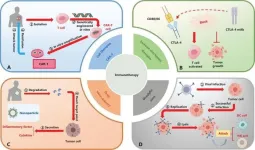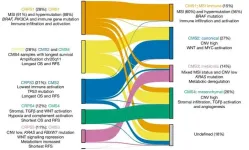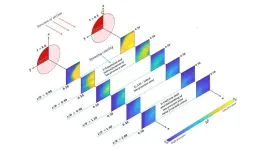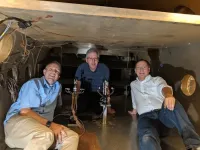(Press-News.org) A study involving 22 Parkinson’s disease (PD) patients has shown that use of the dopaminergic drug levodopa improves sleep quality. When the patients took the drug, the number of times they woke up during the night fell 25% and the amount of time they remained awake fell 30% on average.
The investigation was conducted with FAPESP’s support by researchers at São Paulo State University (UNESP) in Brazil, and the University of Grenoble Alpes (UGA) in France. An article reporting the results is published in the Journal of Sleep Research.
The sleep-wake patterns of PD patients were monitored during four nights with the aid of a wearable actigraph, a wristwatch-like sensor that detects movement. The volunteers were evaluated for three nights after taking the drug and one without it. Curiously, subjective information provided by the PD patients did not suggest any difference in sleep quality with and without the drug, in contrast with the actigraphy results.
“This was the first study to evaluate the effects of the drug on sleep quality in PD patients objectively [using equipment] and to compare them with the results reported subjectively. The actigraphic readings pointed to an improvement in sleep quality after the patients took the drug, although they themselves didn’t experience any benefit. This is important from the standpoint of clinical care. Clinicians should take these findings into account when deciding whether to administer levodopa to PD patients before they go to bed at night,” said Fábio Barbieri, last author of the article. He heads the Human Movement Research Laboratory (MOVI-LAB) and runs a project called “Ativa Parkinson” offering patients physical activities on UNESP’s Bauru campus.
For Barbieri, the discrepancy between the objective and subjective results should not be a surprise. “The perceptions of PD patients are impaired by the disease. The number of waking episodes was ten per night on average, so it’s understandable that they failed to report any improvement. That’s why it’s important to take the actigraphic measurements into consideration,” he said.
Clincher
Levodopa and other dopaminergics are first-line therapeutics for motor symptoms of PD such as tremors and shaking at rest. There appears to be a link between these symptoms and nocturnal waking episodes since the dopaminergic system also plays a key role in sleep regulation. Substantial changes in dopamine levels are known to occur as the brain progresses through the sleep-wake cycle, for example.
Although dopaminergic medication may also improve sleep quality by reducing sleep onset latency (the time taken to fall asleep) and wakefulness in PD patients, there are documented reports of potential sleep disturbance exacerbation resulting from treatment with levodopa. It bears recalling that the drug should be used only when prescribed by a physician. Possible side effects include confusion, drowsiness, insomnia, nightmares, hallucinations, delusion, agitation, anxiety and euphoria.
According to Barbieri, about 90% of PD patients exhibit disturbances such as insomnia, daytime drowsiness and restless leg syndrome, for example. Research has shown that sleep quality is associated with improved early morning mobility and cognition in PD patients.
“Hence the importance of our objective analysis using equipment. It was necessary to verify the impact of the drug on sleep realistically. We concluded that going to bed without the fourth dose was worse,” he said.
Sleep and mobility
Impairment of sleep quality is also associated with freezing of gait – a sudden inability to initiate or continue movement, often resulting in a fall, and one of the most incapacitating symptoms of PD.
In a systematic review of 20 studies, an international group of researchers found that PD patients wake up several times during the night, feel sleepy during the day, and have REM sleep behavior disorder. Rapid eye movement (REM) sleep plays a role in the maintenance of many cognitive processes (read more at: agencia.fapesp.br/50999).
Another study conducted by Barbieri and his group used artificial intelligence to estimate spatial and temporal gait parameters as a basis for precise clinical diagnosis and determining the stage reached in progression of the disease (read more at: agencia.fapesp.br/40102).
This latest study evaluated parameters such as step length, width and velocity, as well as consistency (or width variability). The data is available online for use by other research groups.
About São Paulo Research Foundation (FAPESP)
The São Paulo Research Foundation (FAPESP) is a public institution with the mission of supporting scientific research in all fields of knowledge by awarding scholarships, fellowships and grants to investigators linked with higher education and research institutions in the State of São Paulo, Brazil. FAPESP is aware that the very best research can only be done by working with the best researchers internationally. Therefore, it has established partnerships with funding agencies, higher education, private companies, and research organizations in other countries known for the quality of their research and has been encouraging scientists funded by its grants to further develop their international collaboration. You can learn more about FAPESP at www.fapesp.br/en and visit FAPESP news agency at www.agencia.fapesp.br/en to keep updated with the latest scientific breakthroughs FAPESP helps achieve through its many programs, awards and research centers. You may also subscribe to FAPESP news agency at http://agencia.fapesp.br/subscribe.
END
Study finds that dopaminergic medication improves sleep quality in Parkinson’s disease patients
The analysis was conducted by researchers at São Paulo State University (UNESP), showing that when the patients took the drug, the number of times they woke up during the night fell by 25% and the amount of time they remained awake fell 30% on average.
2024-08-13
ELSE PRESS RELEASES FROM THIS DATE:
Breakthrough in nanotechnology: Viewing the invisible with advanced microscopy
2024-08-13
Tailoring light with Nanomaterials
Metamaterials, engineered at the nanoscale, exhibit unique properties not found in naturally occurring materials. These properties arise from their nanoscale building blocks, which, until now, have been challenging to observe directly due to their size being smaller than the wavelength of light. The team's research overcomes this limitation by employing a new microscopy technique that can simultaneously reveal both the nano and macro structures of these materials.
A New Window into the Nano World
The key finding of this research is a methodological breakthrough that enables the visualization of structures previously too small to be seen ...
Tackling cancer from the inside out: A deep dive into immune checkpoint inhibitors
2024-08-13
In the past two decades, immune checkpoint inhibitors (ICIs) have revolutionized cancer treatment, showing promising results against various solid tumors. This study reviews recent developments in ICIs, focusing on new targets like T cell immunoreceptor with Ig and ITIM domains (TIGIT), T cell immunoglobulin and mucin domain-containing protein 3 (TIM-3), and lymphocyte activation gene-3 (LAG-3). These targets aim to overcome resistance mechanisms limiting the effectiveness of current therapies, such as anti-PD-1 and anti-CTLA-4. By identifying and developing these new ...
RPI Physicist Moussa N’Gom is using light to enhance nuclear security
2024-08-13
Our nation’s security depends on the effective detection of nuclear materials at our borders and beyond. To address this challenge, Rensselaer Polytechnic Institute (RPI) physicist Moussa N’Gom, Ph.D., is leading research aimed at developing a quantum sensing probe to detect and characterize special nuclear materials precisely and without contact. Special nuclear materials are only mildly radioactive but can be used in nuclear explosives.
The research is being conducted through RPI’s participation in the Consortium ...
The atmosphere in the room can affect strategic decision-making, study finds
2024-08-13
The atmosphere within a group can influence the outcome of strategic decision-making, according to a new study co-authored by Bayes Business School (formerly Cass).
Paula Jarzabkowski, Professor of Strategic Management at Bayes, along with researchers from University of Queensland, Macquarie University and Leuphana University of Lüneburg, found that different atmospheres led to people speaking and interacting in different ways that changed how they made sense of the strategy.
For instance, when the atmosphere was pensive, people were cautious about the way to proceed, whereas, when it was curious they felt ...
Study uncovers mutated driver genes in colorectal cancer: 9 novel to CRC and 24 previously undetected in any cancer
2024-08-13
The Institute of Intelligent Medical Research (IIMR) of BGI Genomics, in collaboration with Sweden’s Uppsala University, has published the largest multi-omics study of colorectal cancer (CRC) to date. The study aimed to understand the functional and prognostic impact of cancer-causing somatic mutations, revealing new genetic alterations and developing a new molecular classifier of tumor variants. This research was published in the journal Nature on August 7th, 2024.
Unveiling New Genetic Landscapes
The researchers analyzed the whole genomes and transcriptomes ...
Cricket physics: Science behind the modern bowler technique tricking batters
2024-08-13
WASHINGTON, Aug. 13, 2024 – Key to winning a cricket match is tricking the other team’s batters – no small feat as bowlers bowl cricket balls nearly 100 miles per hour. In recent years, a bowling technique that has become popular involves keeping the arm almost entirely horizontal during delivery, notably used by Sri Lankan stars Lasith Malinga and Matheesha Pathirana. The aerodynamics of such deliveries have perplexed sports physicists.
In Physics of Fluids, by AIP Publishing, researchers have started to unravel the mysteries of how ...
Measuring Martian winds with sound
2024-08-13
WASHINGTON, Aug. 13, 2024 – Mars has a notoriously inhospitable environment, with temperatures that fluctuate dramatically over the course of a Martian day and average minus 80 degrees Fahrenheit. Its surface is mostly covered in red dust, with terrain typified by craters, canyons, and volcanoes. And its atmosphere is extremely thin, comprising only about 1% of the density of Earth’s.
Needless to say, measuring wind speeds on the red planet is challenging. Martian landers have been able capture measurements — some gauging the cooling rate of heated materials ...
Posttraumatic stress disorder and type 2 diabetes outcomes in veterans
2024-08-13
About The Study: The findings of this cohort study of patients with comorbid posttraumatic stress disorder (PTSD) and type 2 diabetes suggest that PTSD is a modifiable risk factor associated with a modest reduction in microvascular complications. Further research is needed to determine whether findings are similar in non-Veterans Health Administration health care settings.
Corresponding Author: To contact the corresponding author, Jeffrey F. Scherrer, PhD, email jeffrey.scherrer@health.slu.edu.
To access the embargoed study: Visit our For The Media website at this link https://media.jamanetwork.com/
(doi:10.1001/jamanetworkopen.2024.27569)
Editor’s ...
Smartwatch measures of outdoor exposure and nearsightedness in children
2024-08-13
About The Study: In this 1-year prospective cohort study of children with smartwatches, continuous outdoor exposure with at least 15 minutes accompanied with no less than 2,000 lux sunlight intensity was associated with less myopic shift. These findings suggest that future outdoor interventions should focus not only on the overall time outdoors but also on the effective outdoor exposure patterns, as a means to effectively prevent myopia (nearsightedness) in children.
Corresponding Authors: To ...
Lurie Children’s Hospital awarded $12 million by PCORI to study best approach to treat mild pneumonia in young children
2024-08-13
Ann & Robert H. Lurie Children’s Hospital of Chicago, in partnership with University of Utah Health, has been approved for $12 million in research funding by the Patient-Centered Outcomes Research Institute (PCORI) for a study that will compare two ways to use antibiotics in young children with mild pneumonia, one of the leading reasons children seek acute care, who are well enough to be cared for at home.
The first approach is to prescribe and give antibiotics immediately, which is the current standard of care. The second way is to prescribe an antibiotic but not give it unless the child’s symptoms worsen or ...
LAST 30 PRESS RELEASES:
UVA’s Jundong Li wins ICDM’S 2025 Tao Li Award for data mining, machine learning
UVA’s low-power, high-performance computer power player Mircea Stan earns National Academy of Inventors fellowship
Not playing by the rules: USU researcher explores filamentous algae dynamics in rivers
Do our body clocks influence our risk of dementia?
Anthropologists offer new evidence of bipedalism in long-debated fossil discovery
Safer receipt paper from wood
Dosage-sensitive genes suggest no whole-genome duplications in ancestral angiosperm
First ancient human herpesvirus genomes document their deep history with humans
Why Some Bacteria Survive Antibiotics and How to Stop Them - New study reveals that bacteria can survive antibiotic treatment through two fundamentally different “shutdown modes”
UCLA study links scar healing to dangerous placenta condition
CHANGE-seq-BE finds off-target changes in the genome from base editors
The Journal of Nuclear Medicine Ahead-of-Print Tip Sheet: January 2, 2026
Delayed or absent first dose of measles, mumps, and rubella vaccination
Trends in US preterm birth rates by household income and race and ethnicity
Study identifies potential biomarker linked to progression and brain inflammation in multiple sclerosis
Many mothers in Norway do not show up for postnatal check-ups
Researchers want to find out why quick clay is so unstable
Superradiant spins show teamwork at the quantum scale
Cleveland Clinic Research links tumor bacteria to immunotherapy resistance in head and neck cancer
First Editorial of 2026: Resisting AI slop
Joint ground- and space-based observations reveal Saturn-mass rogue planet
Inheritable genetic variant offers protection against blood cancer risk and progression
Pigs settled Pacific islands alongside early human voyagers
A Coral reef’s daily pulse reshapes microbes in surrounding waters
EAST Tokamak experiments exceed plasma density limit, offering new approach to fusion ignition
Groundbreaking discovery reveals Africa’s oldest cremation pyre and complex ritual practices
First breathing ‘lung-on-chip’ developed using genetically identical cells
How people moved pigs across the Pacific
Interaction of climate change and human activity and its impact on plant diversity in Qinghai-Tibet plateau
From addressing uncertainty to national strategy: an interpretation of Professor Lim Siong Guan’s views
[Press-News.org] Study finds that dopaminergic medication improves sleep quality in Parkinson’s disease patientsThe analysis was conducted by researchers at São Paulo State University (UNESP), showing that when the patients took the drug, the number of times they woke up during the night fell by 25% and the amount of time they remained awake fell 30% on average.





